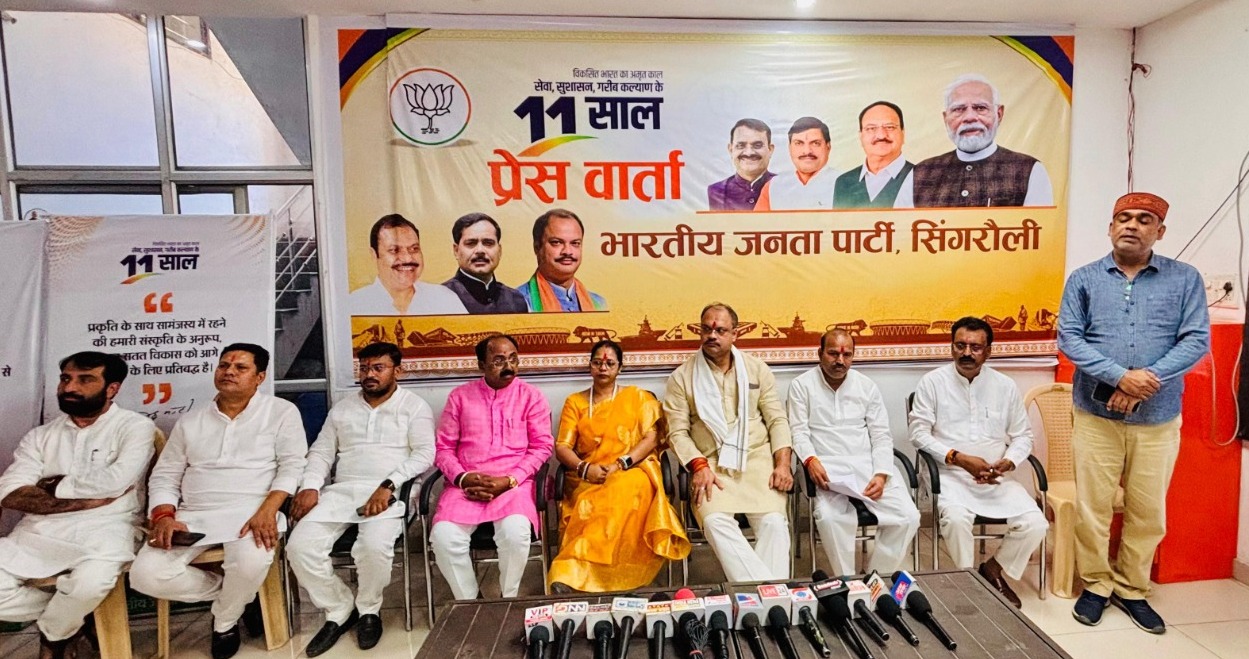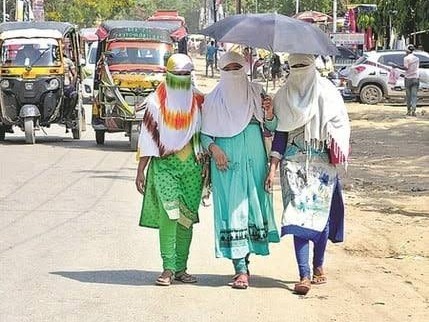 Singrauli News: 11 वर्ष पूर्ण होने के अवसर पर भाजपा कार्यालय सिंगरौली मे प्रदेश महामंत्री ने पत्रकार
Singrauli News: 11 वर्ष पूर्ण होने के अवसर पर भाजपा कार्यालय सिंगरौली मे प्रदेश महामंत्री ने पत्रकार Singrauli News: जिले में भीषण गर्मी का कहर पारा 40 डिग्री, गर्मी-उमस से लोग परेशान
Singrauli News: जिले में भीषण गर्मी का कहर पारा 40 डिग्री, गर्मी-उमस से लोग परेशान Singrauli News: गनियारी में अवैध खनन माफिया का बढ़ता आतंक, खनिज विभाग व पुलिस निष्क्रिय
Singrauli News: गनियारी में अवैध खनन माफिया का बढ़ता आतंक, खनिज विभाग व पुलिस निष्क्रिय Singrauli News: सामुदायिक स्वास्थ्य केंद्र देवसर में समय पर नहीं आते डॉक्टर, मरीज होते है परेशान
Singrauli News: सामुदायिक स्वास्थ्य केंद्र देवसर में समय पर नहीं आते डॉक्टर, मरीज होते है परेशान Indian Coast Guard Recruitment 2025: भारतीय तटरक्षक बल में युवाओं के लिए
Indian Coast Guard Recruitment 2025: भारतीय तटरक्षक बल में युवाओं के लिए  Pathankot News: पठानकोट में एयरफोर्स के अपाचे हेलीकॉप्टर की आपात लैंडिंग, इलाके में मचा हड़कंप
Pathankot News: पठानकोट में एयरफोर्स के अपाचे हेलीकॉप्टर की आपात लैंडिंग, इलाके में मचा हड़कंप Plane Crash: ऐसा लगा प्लेन कहीं फंस गया है, नजरों के सामने एयर होस्टेस खत्म हो गईं: रमेश विश्वास
Plane Crash: ऐसा लगा प्लेन कहीं फंस गया है, नजरों के सामने एयर होस्टेस खत्म हो गईं: रमेश विश्वास Ahmedabad Plane Crash: अहमदाबाद हादसे के बाद बीमा कंपनियों को कितना करना पड़ेगा भुगतान? क्या है नियम
Ahmedabad Plane Crash: अहमदाबाद हादसे के बाद बीमा कंपनियों को कितना करना पड़ेगा भुगतान? क्या है नियम Ahmedabad Plane Crash : पीएम मोदी ने अहमदाबाद विमान दुर्घटना के मद्देनजर की समीक्षा बैठक
Ahmedabad Plane Crash : पीएम मोदी ने अहमदाबाद विमान दुर्घटना के मद्देनजर की समीक्षा बैठक  New training initiative launched to prepare youth for green jobs
New training initiative launched to prepare youth for green jobs
India’s digital economy expected to contribute one-fifth of national income by 2029-30
 India’s digital economy expected to contribute one-fifth of national income by 2029-30
India’s digital economy expected to contribute one-fifth of national income by 2029-30
As Prime Minister Narendra Modi marks 11 years in office, India’s digital economy is poised to become a cornerstone of national growth, projected to account for nearly one-fifth of the country’s income by 2029-30. According to the State of India’s Digital Economy Report 2024, India ranks as the third most digitized economy globally and 12th among G20 nations for individual user digitalization, reflecting remarkable progress in digital transformation over the past decade.
The digital economy, contributing 11.74% of India’s GDP (Rs. 31.64 lakh crore or USD 402 billion) in 2022-23, is growing nearly twice as fast as the overall economy. Employing 14.67 million workers—2.55% of the workforce—it is almost five times more productive than other sectors. Under PM Modi’s leadership, this sector has flourished, driven by digital-enabling industries like ICT services, electronic component manufacturing, and communication equipment, which account for 7.83% of Gross Value Added (GVA). Digital platforms and intermediaries contribute an additional 2% of GVA, while digitalization in traditional sectors such as banking, financial services, insurance (BFSI), retail, and education adds another 2%.
By 2029-30, the digital economy is expected to outpace agriculture and manufacturing, fueled by rapid adoption of artificial intelligence (AI), cloud services, and the expansion of global capability centers (GCCs). India hosts 55% of the world’s GCCs, which are offshore hubs established by multinational corporations for services like R&D, IT support, and business process management. The growth of digital intermediaries and platforms is anticipated to lead in the short term, with broader digital diffusion across the economy reducing the relative share of ICT industries over time.
Digital transformation is reshaping traditional sectors unevenly. In BFSI, over 95% of banking payment transactions are digital, but revenue-generating activities like loans and investments remain largely offline. Retail is embracing omni-channel models, with e-tailers adding physical stores and leveraging AI chatbots and digital inventory tools for efficiency. Education is adopting hybrid models combining offline and online learning, while hospitality and logistics are integrating AI, metaverse technologies, and digital tools, though smaller firms lag behind larger ones in full digitalization.
The digital economy’s growth rate of 17.3% over the past decade surpasses the overall economy’s 11.8%. Digital platforms, in particular, are projected to grow at approximately 30% in the coming years. In 2022-23, the sector employed 14.67 million workers, with 58.07% in digital-enabling industries. Notably, digital platforms are creating job opportunities for women, overcoming barriers related to mobility and safety, though the workforce remains predominantly male.




